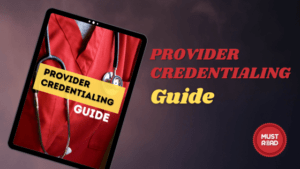When was the last time you renewed provider credentialing documents? Did you know that renewal of credentialing documents is necessary once in three years? Provider credentialing involves many aspects. The main concept of provider credentialing is to prove the education, training and skills of healthcare professionals required for better patient responsibility and care.
Meanwhile, healthcare organizations also would need to monitor the works of healthcare professionals in order to evaluate in terms of medical care and other reports of improper patient responsibility. The above reporting and monitoring should be followed continuously by also having regular checks by healthcare facilities, employ providers and healthcare insurance companies.
It’s quite certain that provider credentialing process will need to have significant work to clear the complex confusions on offer recommendations and fulfilling responsibilities.
Basics of Provider Credentialing:
- In healthcare industry, provider credentialing refers to the process in which healthcare organizations attempt to verify the details or the information of healthcare providers to make sure if they have held proper licenses, certifications and skills to take care of patients with better treatment.
- The same process is also termed as physician credentialing, medical or doctor credentialing and is most often associated with healthcare professionals those who are authorized but less extensive.
What are the other credentialing ways?
- The other ways of credentialing in healthcare industry is as follows:
- Insurance Credentialing: Insurance credentialing is nothing but getting on insurance panels. It is how healthcare insurance companies complete their verification process with healthcare professionals. Every healthcare insurance company must check the credentialing information of their healthcare professionals before adding the physician in-network.
- Paperless Credentialing: It’s all about the software that accelerates the credentialing process by avoiding the paperwork. This actually eliminates and decreases the paper format.
- Vendor Credentialing: Vendor credentialing mainly refers to healthcare organizations that has an idea to check and monitor the training sessions and background of vendors those who require access to healthcare facilities.
Systems that Regulate Provider credentialing standards:
- CMS- The Centers for Medicare and Medicaid Services, Joint Commission on Accreditation of Healthcare Organizations aims towards healthcare professionals credentialing process.
- Healthcare organizations those do not properly follow CMS regulations are strictly not eligible for Medicare and Medicaid reimbursements or revenue paybacks.
- In the same way, Joint Commission on Accreditation of Healthcare Organizations also supports the genuine way of following regulations.
- Many healthcare organizations in U.S obtain Joint Commission accreditation that’s very essential and necessary for Medicare and Medicaid reimbursements.
- The other groups those set equal standards in support to receive additional accreditations are as follows:
- The National Committee for Quality Assurance
- Utilization Review Accreditation Commission
- The Accreditation Association for Ambulatory Healthcare
- Det Norske Veritas
What are Primary Phases of Provider Credentialing?
- The major and primary phases of provider credentialing is as follows:
1.Gathering Information :
- Healthcare organizations or facilities or healthcare insurance company’s plans often and frequently ask for healthcare professionals’ information on education, background, license and skills.
- Its up to healthcare professionals to submit the detailed information in questionnaire or email or via software.
- There are few cases where healthcare facilities or healthcare insurance companies gets ready to work with third party or outsourcing companies that works along with healthcare professionals to gather information and verify them simultaneously. It makes provider credentialing more efficient and effective.
2.Checking the information:
- Most probably it’s recommended for facilities and insurance companies to have a background check up. They will have to directly approach licensing agencies, medical schools and other organizations to verify and check provider credentialing information.
- In few cases, facilities and insurance companies will have to use provider credentialing software check the information continuously if licensing agencies and other entities or organizations are available accordingly online.
- There are healthcare organizations those use collaboration and working platforms in order to help organize and grasp provided credentialing information via recordings and update them when certain credentials expire.
- The checking also includes the monitoring of medical incident reports, malpractice claims, also other information those would ask questions regarding credentialing or re-credentialing process.
3.Appreciating the Provider with credentials:
- When after the healthcare organizations verify the credentials and find no issues, healthcare organization then appreciates and awards the credentials to the healthcare provider.
- Even the healthcare insurance companies undergo similar process and moreover decide to approve him/her as in-network provider. For which insurance companies will pay the provider for services rendered to patients with insurance.
Very common information required for Provider Credentialing:
- The most common information required for physician or provider credentialing is :
- Name
- If had previous names
- Gender and ethnicity
- Email address
- Phone number
- Citizenship information
- Present photographs
- Current CV
- DOB and Social Security Number
- Education and training
- Residency, license and specialty
- Specialty certificates and Qualifications
- History of career
- NPI, Tax ID number, Board certifications
- Primary contact
- Practice phone number and acceptance of new patients
- Disciplinary actions
- Malpractice claim history
- Professional liability insurance proof
- Medical insurance documents.
- All of this information is required for provider credentialing process takes pretty long time depending on most efficient circumstances.
- Most probably the healthcare professionals can be approved and credentialed for healthcare insurance companies within 30 days.
- The maximum time that takes for provider credentialing process is 60-90 days.
Hope you got the information on Provider Credentialing. For more suggestions, please comment below, we will definitely consider them if relevant. For more queries and updates on healthcare, please subscribe to our blog. Do watch videos for additional support.




